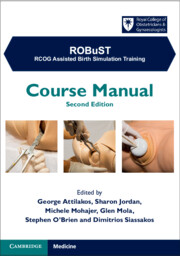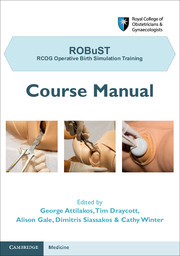16 results

ROBuST: RCOG Assisted Birth Simulation Training
- Course Manual
- Coming soon
-
- Expected online publication date:
- June 2024
- Print publication:
- 30 June 2024
-
- Book
- Export citation
Chapter 30 - Team Working, Skills and Drills on the Labour Ward
-
-
- Book:
- Best Practice in Labour and Delivery
- Published online:
- 27 January 2017
- Print publication:
- 24 November 2016, pp 360-369
-
- Chapter
- Export citation
Abbreviations
-
- Book:
- ROBuST: RCOG Operative Birth Simulation Training
- Published online:
- 05 June 2014
- Print publication:
- 19 December 2013, pp ix-ix
-
- Chapter
- Export citation
Copyright page
-
- Book:
- ROBuST: RCOG Operative Birth Simulation Training
- Published online:
- 05 June 2014
- Print publication:
- 19 December 2013, pp i-iv
-
- Chapter
- Export citation
Advertisements
-
- Book:
- ROBuST: RCOG Operative Birth Simulation Training
- Published online:
- 05 June 2014
- Print publication:
- 19 December 2013, pp -
-
- Chapter
- Export citation
Contents
-
- Book:
- ROBuST: RCOG Operative Birth Simulation Training
- Published online:
- 05 June 2014
- Print publication:
- 19 December 2013, pp v-v
-
- Chapter
- Export citation
Acknowledgements
-
-
- Book:
- ROBuST: RCOG Operative Birth Simulation Training
- Published online:
- 05 June 2014
- Print publication:
- 19 December 2013, pp viii-viii
-
- Chapter
- Export citation

ROBuST: RCOG Operative Birth Simulation Training
- Course Manual
-
- Published online:
- 05 June 2014
- Print publication:
- 19 December 2013
Contributors
-
-
- Book:
- ROBuST: RCOG Operative Birth Simulation Training
- Published online:
- 05 June 2014
- Print publication:
- 19 December 2013, pp vi-vii
-
- Chapter
- Export citation
ROBuST - Half title page
-
- Book:
- ROBuST: RCOG Operative Birth Simulation Training
- Published online:
- 05 June 2014
- Print publication:
- 19 December 2013, pp i-iv
-
- Chapter
- Export citation
ROBuST - Title page
-
-
- Book:
- ROBuST: RCOG Operative Birth Simulation Training
- Published online:
- 05 June 2014
- Print publication:
- 19 December 2013, pp i-iv
-
- Chapter
- Export citation
Index
-
- Book:
- ROBuST: RCOG Operative Birth Simulation Training
- Published online:
- 05 June 2014
- Print publication:
- 19 December 2013, pp 138-144
-
- Chapter
- Export citation
Chapter 19 - Ultrasonography and incidental ovarian pathology
- from Section 2: - Ultrasonography in infertility
-
-
- Book:
- Ultrasonography in Reproductive Medicine and Infertility
- Published online:
- 07 September 2011
- Print publication:
- 25 March 2010, pp 155-162
-
- Chapter
- Export citation
Contributors
-
-
- Book:
- Ultrasonography in Reproductive Medicine and Infertility
- Published online:
- 07 September 2011
- Print publication:
- 25 March 2010, pp ix-xii
-
- Chapter
- Export citation
Contributors
-
-
- Book:
- Best Practice in Labour and Delivery
- Published online:
- 15 March 2010
- Print publication:
- 17 September 2009, pp vii-x
-
- Chapter
- Export citation
29 - Teamworking, skills and drills
-
-
- Book:
- Best Practice in Labour and Delivery
- Published online:
- 15 March 2010
- Print publication:
- 17 September 2009, pp 323-331
-
- Chapter
- Export citation



